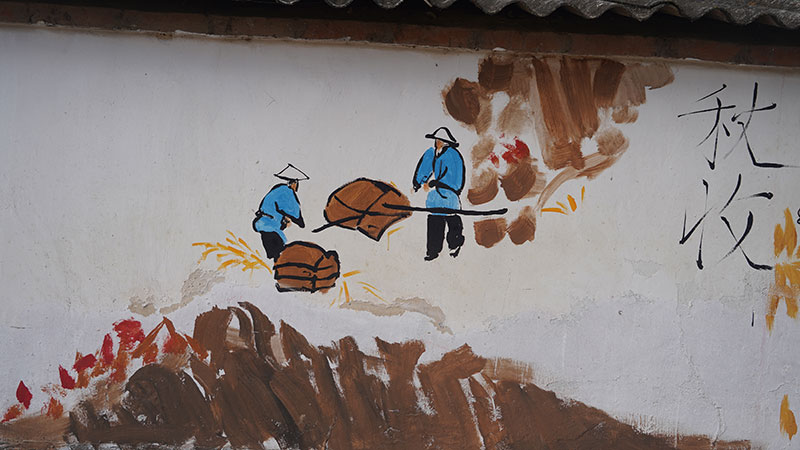Feature: A Chinese house reborn in West Virginia bridging two worlds
Editor's note: The hope for the China-U.S. relationship lies in the people, with grassroots connections as its foundation. While the two countries have experienced ups and downs in their bilateral ties, it is the enduring friendship between their peoples that has consistently infused warmth and momentum into this relationship. As Jan. 1 marks the 46th anniversary of the normalization of China-U.S. relations, Xinhua is releasing a series of stories highlighting Americans who deeply appreciate Chinese culture and work actively to bridge the differences between the two nations.
BEIJING, Dec. 23 (Xinhua) -- "Almost heaven, West Virginia..." decades after John Denver's iconic song introduced the Appalachian beauty to Chinese audiences, an American educator has brought a traditional Chinese house to Harpers Ferry, offering locals a glimpse into the enchanting landscapes of southwestern China.
This two-story wooden house, adorned with distinctive ethnic designs, intricate carvings and ornate patterns, was once a rural home in southwest China's Yunnan Province. It now stands amidst the woods of Harpers Ferry in West Virginia.
"A house is like a book that you can walk into. It's like a text of everyday life that you can experience," said John Flower, who moved the house all the way from China to the United States. "I want to use it to tell stories and show people that China is an amazing place."
Reflecting on the journey of discovering, dismantling, shipping and reconstructing the house, he highlighted the collaborative efforts of people from both countries that turned his "crazy idea" into a reality.
A CRAZY IDEA
Flower used the Chinese word "yuan fen" (karmic tie) to describe his initial encounter with the house.
It happened years ago when Flower, working as a history teacher and the director of Chinese Studies program at Sidwell Friends School, took a group of students to Diqing Tibetan Autonomous Prefecture of Yunnan, as part of a study program.
They arrived at Cizhong, a village nestled along the banks of the Lancang River, where they met villager Zhang Jianhua who warmly invited them into his home for tea.
The village had a power supply, but it was unreliable during inclement weather. The local government planned to build a power station on the river, and a new dam would cause the river to flood large swathes of land, including the area where Zhang's home stood.
"I said to him, your house is beautiful, and it's a pity that it's going to be flooded. I wish I could just take it home with me," recalled Flower, noting that Zhang promptly agreed to the "crazy idea."
The structure, built in 1989, appeared no different from any other farmhouse in the village. Yet, Flower felt it was exactly what he wanted -- an ordinary dwelling that could offer Americans an authentic glimpse into real Chinese life.
"Houses are great ways of learning about the culture and the history of people, and people's lives are inscribed in their homes," he said.
In the summer of 2017, Flower arrived at Cizhong with a colleague, two students and a guitar maker. Together, they meticulously examined the house, from the peak of its roof to its foundation, mapping it out and creating a 3D model.
After weeks of preparation, Flower and his team, joined by a group of local carpenters of Bai ethnicity, carefully dismantled the house piece by piece. With the support of his Chinese friends, Flower obtained the necessary permissions to export the house's components out of China.
Packed into a shipping container along with traditional furniture, the structure embarked on a long journey to the United States.
The rebuilding project began in 2019, with volunteers from the West Virginia Timber Framers Guild lending their expertise to reconstruct the frame.
"They volunteered for two weeks, but they were thanking me the whole time for bringing them such a cool kind of project," Flower said.
Once the frame was in place, Flower's students swung into action. "Most of the work, honestly, was done by these young people," he said. "It's great for them to do something with their hands, and they get to be part of something bigger than themselves."
"All together about 22,000 hours of volunteer labor have gone into the house," Flower said.
A BRIDGE OF FRIENDSHIP
Now known as the China Folk House, the house serves as both a museum and a venue for cultural exchange, education and music, bringing together Flower's students, local residents and the Chinese-American community.
The house serves as both an effective teaching tool and a bridge of friendship. "Without this house, I could only take a handful of students to China, but now, I can bring hundreds of students to see a part of China that was brought back to the United States," Flower said.
According to him, some visitors from the countryside have been surprised to discover many commonalities between themselves and rural Chinese in terms of house-building traditions and ways of life, thus creating a connection between local communities in both countries.
"The house offers Americans a more tangible experience of China," Flower said. "When you think about something as an abstraction, it's easy to project negative connotations on it, but when you see something real and reliable, you will have a more nuanced understanding."
The passion for the house is shared on both sides of the Pacific. Last year, Flower received more than 14,000 roof tiles donated by Kunming University of Science and Technology in Yunnan to help complete the building.
Wu Zhihong, dean of the school of architecture of the university, said, "The reconstruction of a Chinese building was no easy job for Flower and his students who are from such a different cultural background."
"By giving the tiles, we want to show our appreciation for what Flower has done in promoting cultural exchange," Wu said. "China-U.S. relations have been strained for a while, but people-to-people exchanges have the potential to gradually dispel misunderstandings."
Zhang Jianhua, the former owner of the house, now lives in a larger home with better access to water and electricity.
"I feel so proud that my former home has been appreciated internationally," he said. "Hopefully it will introduce more and more Americans to Chinese culture and history."
A LOVE THAT BLOSSOMS
Flower first encountered Chinese culture as a college student majoring in philosophy in the late 1970s. "My introduction to the Chinese language was reading The Analects of Confucius," he said.
It was also the era of normalization of China-U.S. relations, which opened up opportunities for mutual visits.
Flower first visited China in 1991 and later spent several years living in the countryside of the southwestern Sichuan Province with his wife. During this time, his understanding of Chinese culture deepened, and he developed a strong interest in exploring rural China.
"What I appreciate most about Chinese culture is the close bond between people, which plays a big role in Chinese society, especially in the rural areas," he said.
In 2007, he resigned from his tenured position as a university professor of East Asian history and began teaching at Sidwell Friends, where he introduced high school students to the richness of Chinese culture.
Over the past decade, Flower has taken his students to rural Yunnan for experiential learning projects.
"Yunnan has the perfect combination of biodiversity and cultural diversity and traditional practices that are still part of everyday life," he said.
Comparing Yunnan with West Virginia, Flower said the two places share "a lot of common values and common folkways."
One reason Flower chose West Virginia as the location for the folk house is that from the Himalayas and Lancang River to the Blue Ridge Mountains and Shenandoah River -- two places that are far apart -- there are many striking similarities, he explained.
"They're both really beautiful places. Almost heaven."
Photos
Related Stories
- Commentary: China stands committed to steady development of China-U.S. ties
- Kuliang forum held in Beijing to discuss China-U.S. relations
- China to continue counternarcotics cooperation with U.S. on basis of equality, mutual benefit and respect: FM spokesperson
- China's top political advisor meets with Harvard professor
- China ready to maintain dialogue, enhance mutual trust, expand cooperation with U.S.: top diplomat
- China-U.S. financial working group holds seventh meeting
Copyright © 2024 People's Daily Online. All Rights Reserved.









